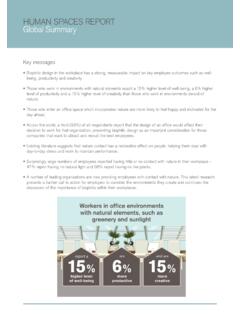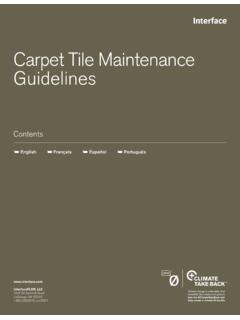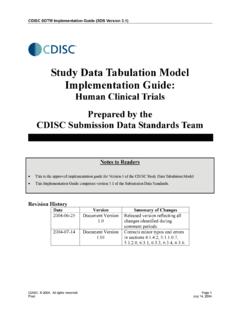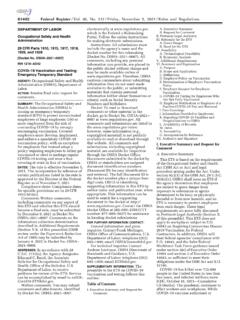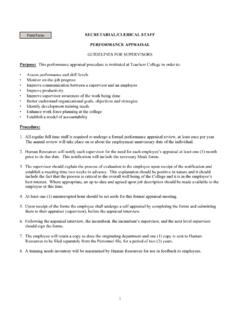Transcription of Fire testing of floor coverings
1 Fire testing of floor coveringsThe objective of fire safety is to prevent the spread of hazardous fires and, in the event of a fire, to provide for effective firefighting to prevent injury and loss of life. For such reasons it is prohibited to use construction products that are still easily flammable after installation in public Construction Products Regulation (CPR 305/2011) is used in the floor coverings sector throughout Europe and requires products to be assessed against one or more of the test standards specified in EN 14041 Resilient, textile and laminate floor coverings . Essential characteristics. One such standard relates to reaction to fire is carried out in accordance with EN 13501-1 which provides the reaction to fire classification procedure for all construction products since 2002.
2 This European standard supersedes national standards for reaction to fire testing meaning every member country of the European Union is responsible for incorporating and adopting this classification standard in it s country specific rules and fire classifications are therefore a thing of the past with tests such as the German B1, French M3 and the UK hot metal nut no longer applicable. This should remove some of the complexity with regards to understanding the different national fire classification systems and should also make it simpler when selecting products tested and classified the same way. However, it has created some misunderstanding with regards to the different classes of product and misleading competitor claims often add to this 13501-1 consists of four European reaction to fire test methods that can be applied to floor coverings but for textile, resilient and laminate floors EN ISO 11925-2 and EN ISO 9239-1 are the most important test methods called up for classification purposes.
3 Commercial and contract application flooring products will be tested according to these methods which need to be met to obtain class Bfl, Cfl or Dfl classification. For residential products Class Efl is generally testing of floor coverings2 floor coverings are deemed to be fire-retardant if they satisfy the requirements of the radiant-panel test for fire classes Bfl and Cfl. The radiant-panel test according to EN ISO 9239-1 describes a test procedure for assessing the burning behaviour (spread of flame and smoke development) of horizontally mounted floorcoverings firstly exposed to a radiant heat source and then ignited with a pilot flame. The test is designed to simulate the conditions experienced by a flooring in a room or corridor during the early stages of a developing fire in an adjacent room.
4 It consists of a gas-air fuelled radiant heat source (panel) and several points of ignition. The specimen is placed horizontally under the radiant panel which is positioned at an angle of 30 degrees to the radiant panel generates a radiant energy flux distribution ranging from a nominal maximum of kW/m2 to a minimum of kW/m2. A propane pilot burner is used to ignite the test specimen and a record is made of the progression of the flame horizontally along the length of the specimen in terms of the time it takes to spread to defined distances. This distance burned until the flames extinguish is converted in to a critical radiant flux which is measured in kW/m2. kW/m2 is the minimum value for the fire classes Bfl and production during the test is recorded as light transmission in the exhaust stack.
5 Here the reduction in light transmission is measured and mapped in a diagram as a function of time. The diagram is then used to determine the result. A value of < 750% x min corresponds to the class s1 little smoke formation with fire. Products which do not satisfy the criteria of class s1 are classified as s2. ALL Interface products satisfy the requirements for s1. NB: s = testing to these two standards, classification of the flooring is then according to EN : Neither EN ISO 11925-2 nor EN ISO 9239-1 apply when attempting to install flooring on a wall. Such an installation would change the fire characteristics of a flooring product and for that reason should be EN ISO 9239-1 Reaction to fire tests for floorings. Part 1: Determination of the burning behaviour using a radiant heat source.
6 This test determines the ignitability of a vertically mounted test specimen using the so-called small burner method. In a combustion chamber a vertically positioned sample is exposed to a defined flame on its surface and/or one of it s edges for 15 requirements on construction products of the fire classes Dfl and Efl normally flammable, are deemed to have been satisfied if the tip of the flame does not reach 150mm above the flame impingement point in less than 20 seconds and ALL Interface products will comply. For any products which do not, then that product is classified as Ffl easily flammable. 1. EN ISO 11925-2 - Reaction to fire tests Ignitability of building products subjected to direct impingement of flame. Part 2: Single flame source test 3 This European standard for the fire classification of construction products according to their reaction to fire tests lays down the classes for the flammability of floor coverings , which are now applicable throughout Europe.
7 Further the CE Mark for floor coverings specifies the testing or classification of flammability according to EN following table details the different classes of flammability and comments on the criteria:Construction products classified as A1fl and A2fl are effectively non-combustible and do not contribute to fire at all. These requirements are so very stringent that they cannot be satisfied by certain types of floor coverings including textiles and B to F are combustible materials with classes Bfl and Cfl regarded as flame-retardant floor coverings , Dfl and Efl normally flammable and Ffl easily flammable. Further fire class Cfl corresponds to the previous national building materials fire classes for fire-retardant floor coverings . All Interface products, except for Heuga 493, will satisfy the requirements for Bfl or Cfl and so are flame-retardant.
8 floor coverings classified as A2fl to Dfl must also be tested/classified for smoke density and smoke formation as described earlier and so the final classification relates to how far the flame has spread and smoke development. For Interface this means the fire classification of products is described as Cfl s1 and Bfl s1. The actual fire classification for each Interface product can be found on the website specifications or in the Product Matrix (issued each Quarter as part of the Delivery Guide). At the time of writing this document there are 49 products rated Cfl s1 (at an additional charge 24 of those can be upgraded to Bfl s1 if for some reason that was necessary) and 62 are Bfl s1. When developing new products, the aim is to meet Cfl s1 which is comparable to previous national fire tests, such as the German B1, means the product can be regarded as fire retardant and is a basic requirement for contract flooring applications.
9 Whilst Bfl s1 is the slightly higher classification it effectively means the product is fire retardant and so offers no real differentiator from Cfl s1. It does not mean the product is non-flammable. Further the difference between the two classes relates solely to surface spread of flame and the differences in terms of how far the flame actually spreads during testing can be quite minimal see images of tested specimens below and the slight difference in flame spread Cfl s1 to Bfl s1: To conclude, customers can be assured that Cfl s1 or Bfl s1 products are perfectly suitable ratings for commercial flooring applications and in most country specific rules and regulations Cfl s1 has been adopted as the requirement. Often challenges around Cfl s1 and Bfl s1 are more to do with competitor claims and a lack of understanding on this subject rather than an actual any further information on this subject please contact either Mark Griffin or Leah Thompson-Day.
10 EN 13501-1 Fire classification of construction products and building elements. Classification using test data from reaction to fire tests ClassCommentA1 flOnly achieved by non-flammable floor coverings which do not present any risk in terms of smoke formationA2 flOnly achieved by non-flammable floor coverings with low levels of organic binding agentsB flRadiation intensity of 8 kW/m2 = flame-retardant construction productsC flComparable with German B1 classification. Radiation intensity of kW/m2 = flame-retardant construction productsD flRadiation intensity here only 3 kW/m2 = normally flammable construction productsE flSmall burner test = normally flammable construction productsF flNo requirements made, no test = easily flammable construction productsNB: fl = flooring.
